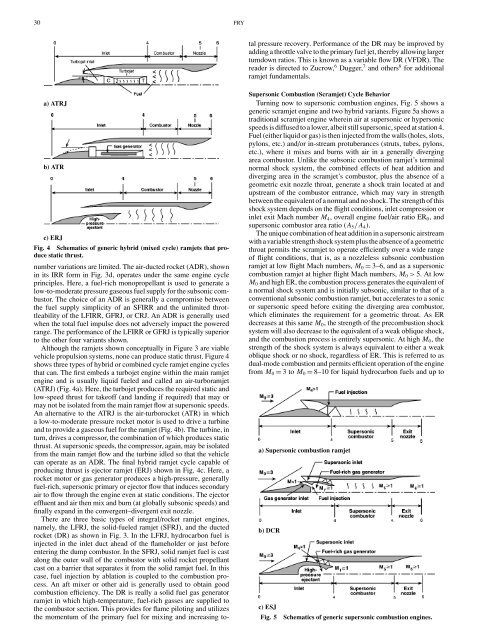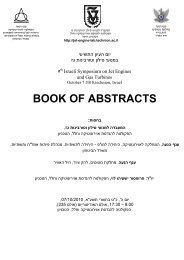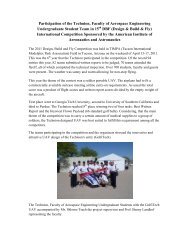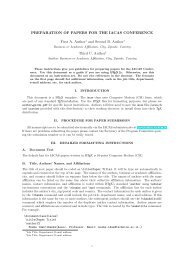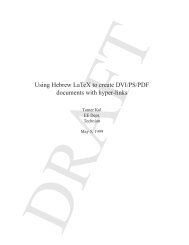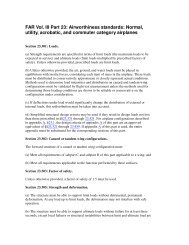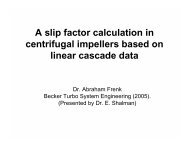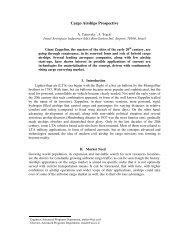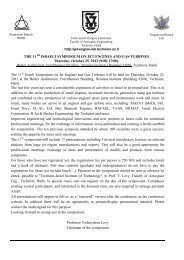A Century of Ramjet Propulsion Technology Evolution - Faculty of ...
A Century of Ramjet Propulsion Technology Evolution - Faculty of ...
A Century of Ramjet Propulsion Technology Evolution - Faculty of ...
Create successful ePaper yourself
Turn your PDF publications into a flip-book with our unique Google optimized e-Paper software.
30 FRY<br />
a) ATRJ<br />
b) ATR<br />
c) ERJ<br />
Fig. 4 Schematics <strong>of</strong> generic hybrid (mixed cycle) ramjets that produce<br />
static thrust.<br />
number variations are limited. The air-ducted rocket (ADR), shown<br />
in its IRR form in Fig. 3d, operates under the same engine cycle<br />
principles. Here, a fuel-rich monopropellant is used to generate a<br />
low-to-moderate pressure gaseous fuel supply for the subsonic combustor.<br />
The choice <strong>of</strong> an ADR is generally a compromise between<br />
the fuel supply simplicity <strong>of</strong> an SFIRR and the unlimited throttleability<br />
<strong>of</strong> the LFIRR, GFRJ, or CRJ. An ADR is generally used<br />
when the total fuel impulse does not adversely impact the powered<br />
range. The performance <strong>of</strong> the LFIRR or GFRJ is typically superior<br />
to the other four variants shown.<br />
Although the ramjets shown conceptually in Figure 3 are viable<br />
vehicle propulsion systems, none can produce static thrust. Figure 4<br />
shows three types <strong>of</strong> hybrid or combined cycle ramjet engine cycles<br />
that can. The first embeds a turbojet engine within the main ramjet<br />
engine and is usually liquid fueled and called an air-turboramjet<br />
(ATRJ) (Fig. 4a). Here, the turbojet produces the required static and<br />
low-speed thrust for take<strong>of</strong>f (and landing if required) that may or<br />
may not be isolated from the main ramjet flow at supersonic speeds.<br />
An alternative to the ATRJ is the air-turborocket (ATR) in which<br />
alow-to-moderate pressure rocket motor is used to drive a turbine<br />
and to provide a gaseous fuel for the ramjet (Fig. 4b). The turbine, in<br />
turn, drives a compressor, the combination <strong>of</strong> which produces static<br />
thrust. At supersonic speeds, the compressor, again, may be isolated<br />
from the main ramjet flow and the turbine idled so that the vehicle<br />
can operate as an ADR. The final hybrid ramjet cycle capable <strong>of</strong><br />
producing thrust is ejector ramjet (ERJ) shown in Fig. 4c. Here, a<br />
rocket motor or gas generator produces a high-pressure, generally<br />
fuel-rich, supersonic primary or ejector flow that induces secondary<br />
air to flow through the engine even at static conditions. The ejector<br />
effluent and air then mix and burn (at globally subsonic speeds) and<br />
finally expand in the convergent–divergent exit nozzle.<br />
There are three basic types <strong>of</strong> integral/rocket ramjet engines,<br />
namely, the LFRJ, the solid-fueled ramjet (SFRJ), and the ducted<br />
rocket (DR) as shown in Fig. 3. In the LFRJ, hydrocarbon fuel is<br />
injected in the inlet duct ahead <strong>of</strong> the flameholder or just before<br />
entering the dump combustor. In the SFRJ, solid ramjet fuel is cast<br />
along the outer wall <strong>of</strong> the combustor with solid rocket propellant<br />
cast on a barrier that separates it from the solid ramjet fuel. In this<br />
case, fuel injection by ablation is coupled to the combustion process.<br />
An aft mixer or other aid is generally used to obtain good<br />
combustion efficiency. The DR is really a solid fuel gas generator<br />
ramjet in which high-temperature, fuel-rich gasses are supplied to<br />
the combustor section. This provides for flame piloting and utilizes<br />
the momentum <strong>of</strong> the primary fuel for mixing and increasing to-<br />
tal pressure recovery. Performance <strong>of</strong> the DR may be improved by<br />
adding a throttle valve to the primary fuel jet, thereby allowing larger<br />
turndown ratios. This is known as a variable flow DR (VFDR). The<br />
reader is directed to Zucrow, 6 Dugger, 7 and others 8 for additional<br />
ramjet fundamentals.<br />
Supersonic Combustion (Scramjet) Cycle Behavior<br />
Turning now to supersonic combustion engines, Fig. 5 shows a<br />
generic scramjet engine and two hybrid variants. Figure 5a shows a<br />
traditional scramjet engine wherein air at supersonic or hypersonic<br />
speeds is diffused to a lower, albeit still supersonic, speed at station 4.<br />
Fuel (either liquid or gas) is then injected from the walls (holes, slots,<br />
pylons, etc.) and/or in-stream protuberances (struts, tubes, pylons,<br />
etc.), where it mixes and burns with air in a generally diverging<br />
area combustor. Unlike the subsonic combustion ramjet’s terminal<br />
normal shock system, the combined effects <strong>of</strong> heat addition and<br />
diverging area in the scramjet’s combustor, plus the absence <strong>of</strong> a<br />
geometric exit nozzle throat, generate a shock train located at and<br />
upstream <strong>of</strong> the combustor entrance, which may vary in strength<br />
between the equivalent <strong>of</strong> a normal and no shock. The strength <strong>of</strong> this<br />
shock system depends on the flight conditions, inlet compression or<br />
inlet exit Mach number M4, overall engine fuel/air ratio ER0, and<br />
supersonic combustor area ratio (A5/A4).<br />
The unique combination <strong>of</strong> heat addition in a supersonic airstream<br />
with a variable strength shock system plus the absence <strong>of</strong> a geometric<br />
throat permits the scramjet to operate efficiently over a wide range<br />
<strong>of</strong> flight conditions, that is, as a nozzleless subsonic combustion<br />
ramjet at low flight Mach numbers, M0 = 3–6, and as a supersonic<br />
combustion ramjet at higher flight Mach numbers, M0 > 5. At low<br />
M0 and high ER, the combustion process generates the equivalent <strong>of</strong><br />
a normal shock system and is initially subsonic, similar to that <strong>of</strong> a<br />
conventional subsonic combustion ramjet, but accelerates to a sonic<br />
or supersonic speed before exiting the diverging area combustor,<br />
which eliminates the requirement for a geometric throat. As ER<br />
decreases at this same M0, the strength <strong>of</strong> the precombustion shock<br />
system will also decrease to the equivalent <strong>of</strong> a weak oblique shock,<br />
and the combustion process is entirely supersonic. At high M0, the<br />
strength <strong>of</strong> the shock system is always equivalent to either a weak<br />
oblique shock or no shock, regardless <strong>of</strong> ER. This is referred to as<br />
dual-mode combustion and permits efficient operation <strong>of</strong> the engine<br />
from M0 = 3toM0 = 8–10 for liquid hydrocarbon fuels and up to<br />
a) Supersonic combustion ramjet<br />
b) DCR<br />
c) ESJ<br />
Fig. 5 Schematics <strong>of</strong> generic supersonic combustion engines.


